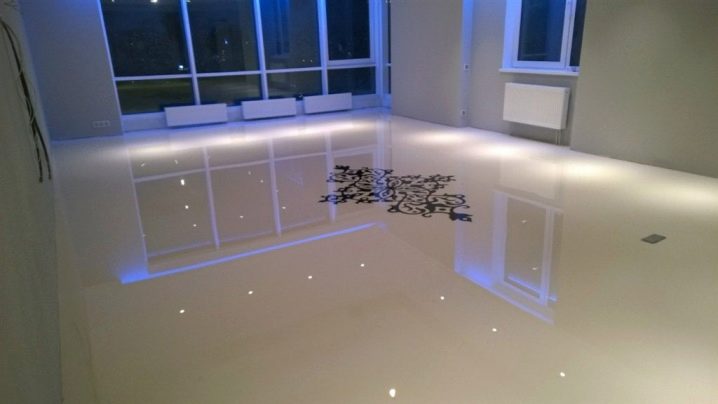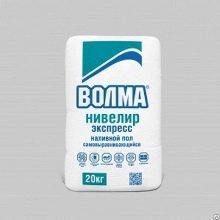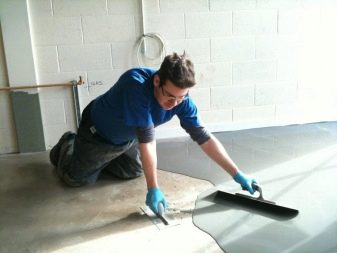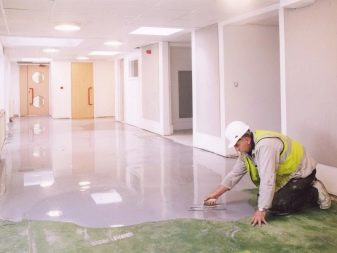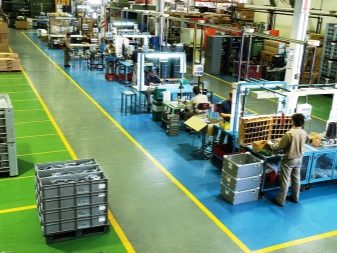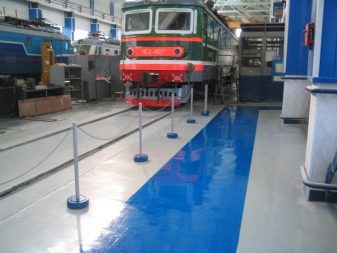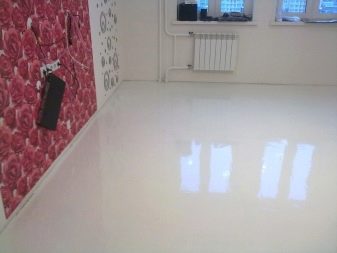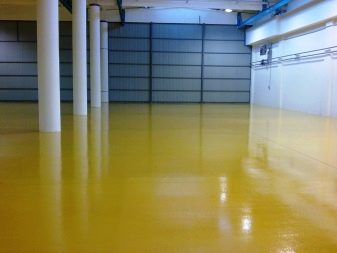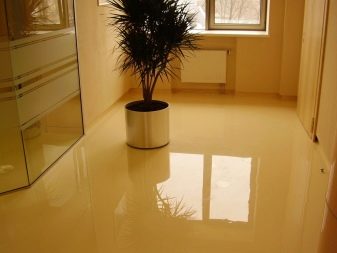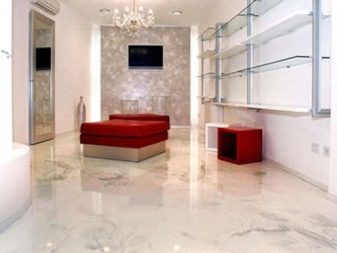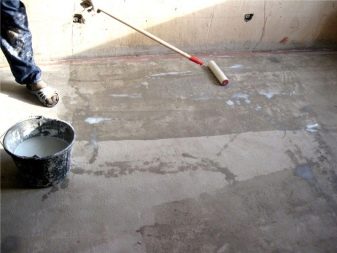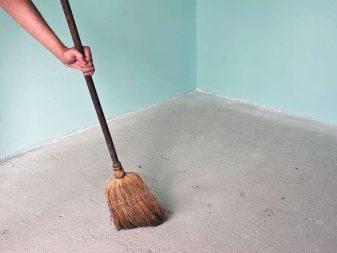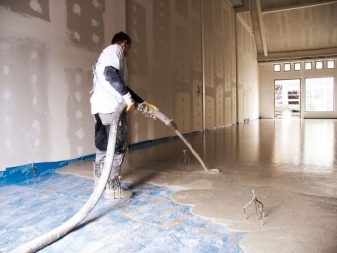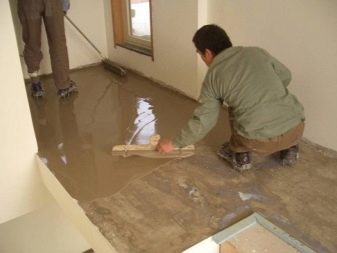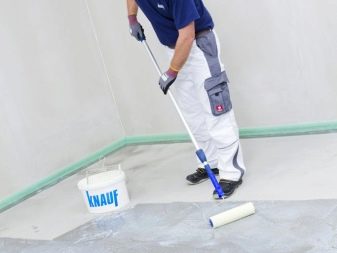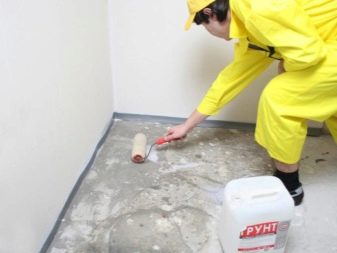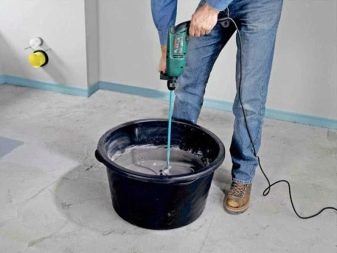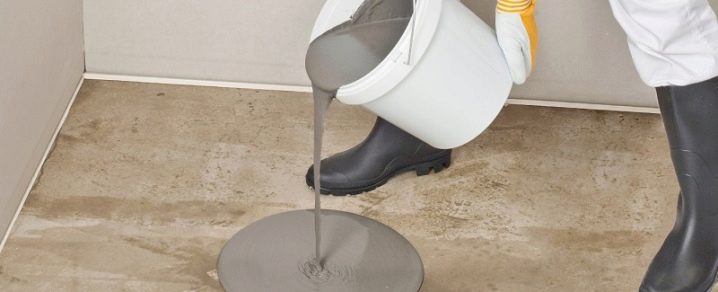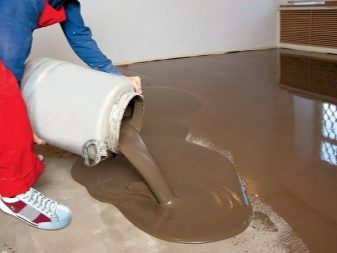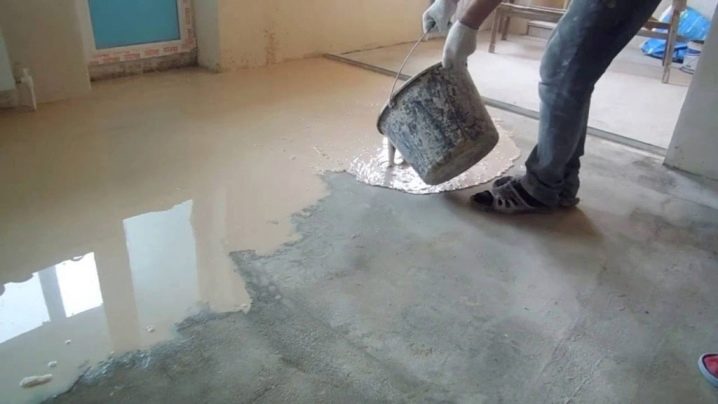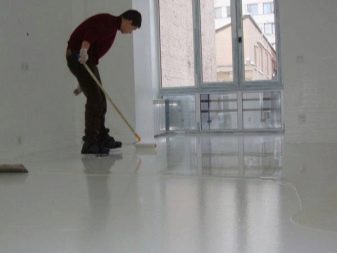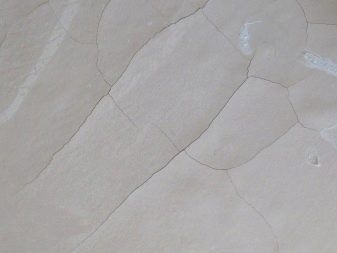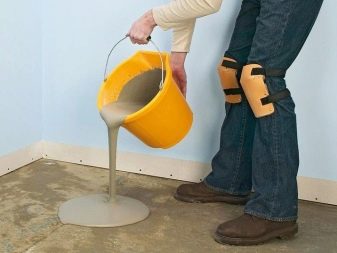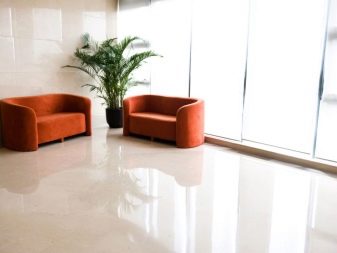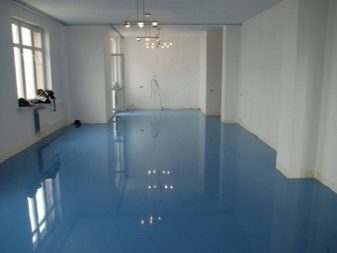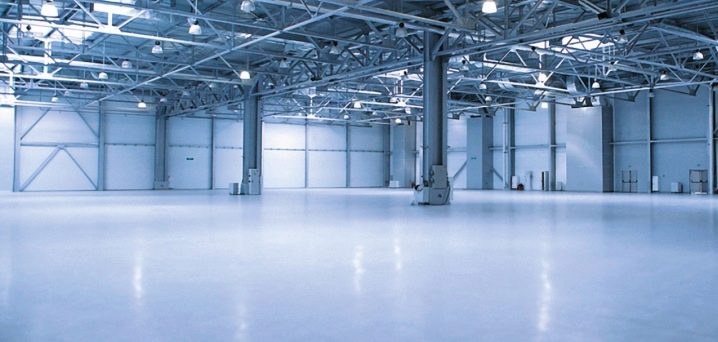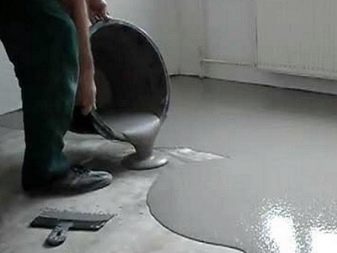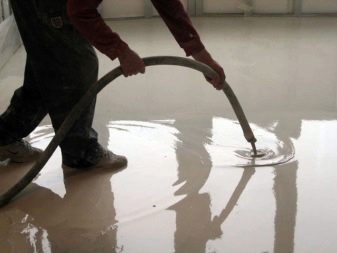Bulk floor "Volma-Nivelir Express"

"Nivelir Express" is the most popular product of the production association "Volma". It is a finishing self-leveling mixture, which is designed to create a rigid base for laying a decorative floor covering.
What it is?
The mixture is made of gypsum base using quartz sand, a polymer modifying agent and binders. The combination of the main components gives the solution high plasticity, ensuring perfect leveling of the subfloor.The thickness of the working layer ranges from 7 to 100 mm, which allows leveling problematic surfaces with large differences in height and pronounced defects. The material has high adhesion properties with the lower plane, which are 2 MPa, which makes it able to withstand a load of up to 16 MPa.
The solution has a short setting time (4-6 hours), depending on the temperature and humidity of the surrounding space.
The complete drying of the composition occurs after 7-10 days and depends on the influence of external factors and the thickness of the applied layer. Packaging the mixture weighs 20 kg, which is enough to fill the centimeter layer of the solution on an area of 4.5 square meters. The cost of the material is 230-250 rubles and makes it the most budgetary option among similar products of European brands.
The shelf life of the dry mixture is 12 months.
Application area
Means "Nivelir Express" is a high-quality leveling material and can only be used for interior work. The composition is used to fill the main floor, made of concrete or cement-sand mixture, and can serve as a rigid base for any type of decorative flooring: carpet, linoleum, parquet, laminate or tile.Due to the optimal cost and excellent quality, the material is used for floor finishing both in new buildings and in public institutions.
Advantages and disadvantages
Means for leveling the floor "Nivelir Express" deservedly enjoys high demand and popularity in the domestic market of building and finishing materials.
The products of Volma are quite recognizable and have the following indisputable advantages:
- The special strength of the material is achieved due to the balanced composition and excellent quality of all components. The surface is impact resistant and not prone to cracking. The mixture can be used for leveling floors in workshops and industrial premises where heavy equipment is to be placed;
- High levels of alignment due to the high ductility and mobility of the solution. The process of pouring does not require special knowledge, skills and additional labor costs. After drying the rough floor does not need additional polishing. Irregularities and height differences are leveled, and the floors acquire an absolutely flat surface.When zoned pouring on the surface does not remain joining seams, and the absence of shrinkage of the material allows you to mount a decorative coating immediately after drying - in 10-14 days;
- The absolute ecological safety of the material is guaranteed by the use of natural ingredients that are completely harmless to health and do not cause allergic reactions;
- The high thermal conductivity of gypsum makes it possible to install floors with electric and water heating without the risk of heat loss;
- Rapid hardening allows you to move on the surface of the floor within 6 hours after pouring. The prepared solution is suitable for use within an hour, and the final hardening occurs after 72 hours.
The disadvantages include the short time the solution is suitable for work. For people who do not have experience in construction, it is difficult to cope with pouring within an hour. In the case of slow work there is a risk of premature setting of the composition with the impossibility of its further use.
This indicator must be taken into account during installation.
Work surface preparation
Before you start pouring, you must carefully prepare the surface. If the cement-sand composition is used as a base, more than 28 days should pass from the moment of its installation. If the base is made of concrete, then its age must be at least 90 days. Works should be performed at a relative humidity of not more than 75% and a temperature not lower than 5 degrees.
The moisture content of the subfloor should not exceed 6%.
The first stage of preparation should be the cleansing of the base from mechanical impurities, dust, grease stains and crumbled fragments of the roughing screed. Around the perimeter, as well as around the columns, it is necessary to lay damping protection, presented in the form of a tape or a thin strip of expanded polystyrene. If there are large cracks and potholes in the base, it is necessary to dilute the mixture “Volma Nivelir” with a small amount of liquid and putty. This should be done 24 hours before the main work. Bearing reinforcement must be isolated, it will save it from possible corrosion and will significantly increase the service life, as well as prevent the destruction of the roughing screed.
On problem floors, for example, heavily contaminated with oil or bitumen mastic, as well as on surfaces with low strength, pouring should be carried out on the separating layer. With a room diagonal exceeding 10 m, the presence of an expansion joint is required, which must be located strictly above the base seam. This will prevent cracking of the gypsum screed in case of unexpected mobility of the base.
At the next stage, you need to prime the rough floor with the adjacent wall sections that will come into contact with the self-leveling screed. Work should be done with a roller or a stiff brush. It is recommended to use a Volma-Aqua primer designed for highly absorbent surfaces. If the base has a porous structure, then it is primed 2-3 times. The interval between treatments should be at least 4 hours.
After the final drying of the primed areas should begin to fill the floor.
Features of the preparation of the mixture
The breeding algorithm is clearly written on the package and is as follows:
- In a clean, dry container you need to pour cool water, the temperature of which does not exceed 20 degrees.The use of warm or hot liquid will lead to rapid solidification of the solution and the impossibility of continuing the casting work. For 1 kg of dry product 0.3 liters of water is required. In order to prepare a solution from a standard twenty-kilogram pack, it will take 6 liters.
Overdose of water is unacceptable - the liquid solution loses its technical features and characteristics, which further leads to the separation of the surface;
- Next, proceed to the backfilling of dry material. The mixture should be added in small portions while stirring. Mixing should be done with a construction mixer or a drill using a special paddle blade;
- It is necessary to leave the resulting solution for 5-10 minutes, and then mix thoroughly again. The consistency of the resulting composition should resemble sour cream;
- The consistency of the resulting solution can be checked by pouring a liter of the mixture on a flat non-absorbent surface.
With an ideal ratio of components, the resulting spot will take the form of a circle with a diameter of just over 50 cm.
Pouring technique
Installation of self-leveling floor should start from the far corner of the room.The mixture is evenly distributed on the floor with a spatula, and the bubbles formed are removed with a needle roller with a telescopic handle. Spikes should be no more than 30 mm in length and exceed the fill layer. The leveling results in an absolutely smooth surface with a characteristic glossy shine.
To comply with the required thickness of the formed layer, you need to use special beacons, setting them at a distance of 1.5 m from each other.
Using a step-by-step fill technique, the strips are applied in parallel until the entire rough foundation of the floor has been filled. When filling the solution, it is necessary to monitor the uniformity of filling and avoid technological interruptions. When the entire surface of the floor is flooded, it is necessary to remove the beacons and levels and quickly walk along the floor with a roller. This will allow you to form a flat surface and smooth out the "folds" that can form when working with a spatula.
Leveling needs to start from the walls or pillars and make it progressive movements in all directions.
The diluted solution should be used within an hour. When pouring large areas of space should be applied zoning methodand carry out the installation of each technological section separately. The area of one zone should not exceed 15 square meters. m. It is possible to walk on the freshly floor after 4 hours after the completion of the work, to lay the tile in 2 days, and lay the linoleum in 10-14 days.
Installation of decorative flooring can be carried out only if the residual moisture level of the self-leveling floor does not exceed 1%.
Useful tips
Before you start pouring you must tightly close the doors and windows. This will help prevent drafts that cause cracking of the drying screed. Direct sunlight should also be avoided: their influence negatively affects the quality of the upper layer. Relative humidity should not exceed 75%.
To ensure natural ventilation it is recommended to carry out short-term regular ventilation.
In cases of violation of the technology of pouring, ingress of excess water into the solution or obvious defects of the main surface of the self-leveling floor can crack within a few hours after installation. If the top layer is peeled off or cracked, it is necessary to embroider, remove dust and prime the cracks.Then you need to fill them with a newly prepared mixture of "Nivelir-Express" or repair composition. Subsequently, the repaired surface is reinforced with plaster mesh or fiberglass.
In case of layering of the self-leveling floor, it is necessary to remove the detached upper layer, and after dedusting and priming, pour in a new solution. If the detachment of the material occurred on a fairly large area, then a spot repair will not help. In this case, you will need to completely dismantle the damaged surface, followed by a new fill.
Reviews
Consumers appreciate the quality of self-leveling mixture "Nivelir-Express" and note the excellent spreading, ease of preparation of the solution and ease of installation. Attention is paid to the shiny flat surface and good alignment of problem areas. The material has a low cost and dries quickly. The disadvantages of plaster mixes "Nivelir-Express" include a very rapid setting of the solution, which requires either work with a partner, or alternately fill individual technological areas. It also indicates the consumption of material, which is slightly higher than those specified in the instructions for use of the norm.Some consumers have noted the formation of sagging after solidification, but this is most likely the result of poor quality leveling of the wet surface using a roller.
Successful examples and options
Volma-Nivelir self-leveling compound will help to achieve an absolutely smooth and durable base on which any decorative coating will last for a very long time without losing its original shape and appearance:
- With proper preparation of the solution and compliance with the technological features of mounting the self-leveling floor on a plaster base will have a perfectly smooth surface with a glossy shine;
- Excellent plasticity of the composition contributes to uniform spreading and allows to level the defects of the subfloor;
- Despite the method of separate pouring of technological areas, which is used in large premises, there are no joints or seams on the frozen surface;
- The mixture is suitable for both manual and machine fill, which is very convenient when installing it in spacious rooms and industrial premises;
- The use of needle rollers allows you to achieve the formation of a smooth surface, which will serve as an excellent basis for linoleum, carpet and tile.
You can find out how to do a do-it-yourself self-leveling floor installation in the video below.
